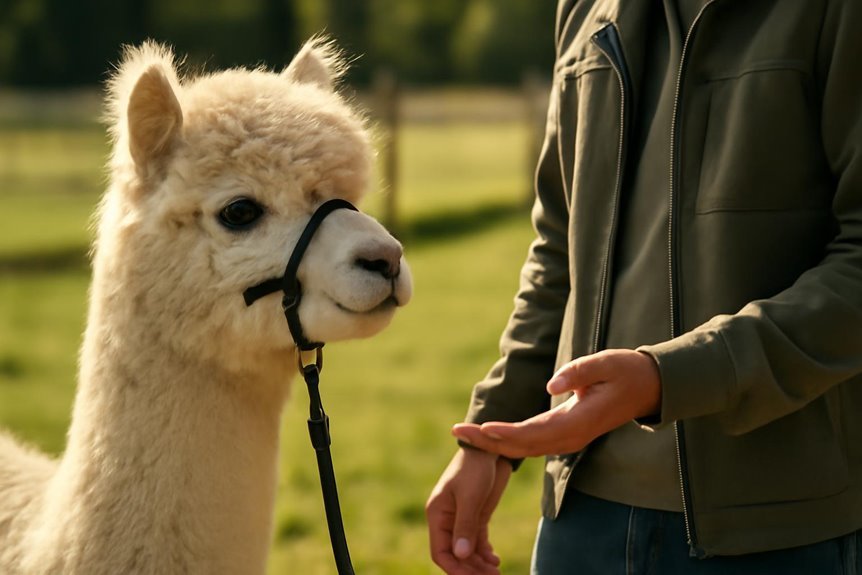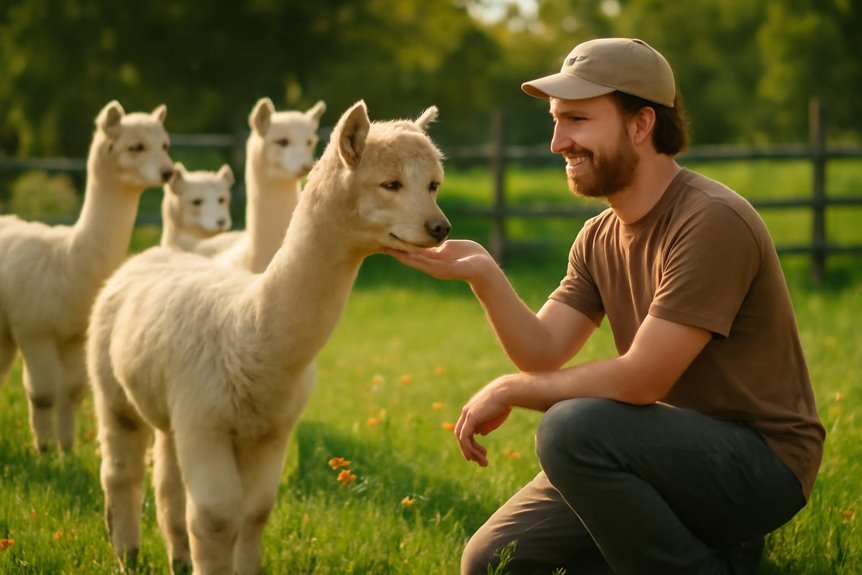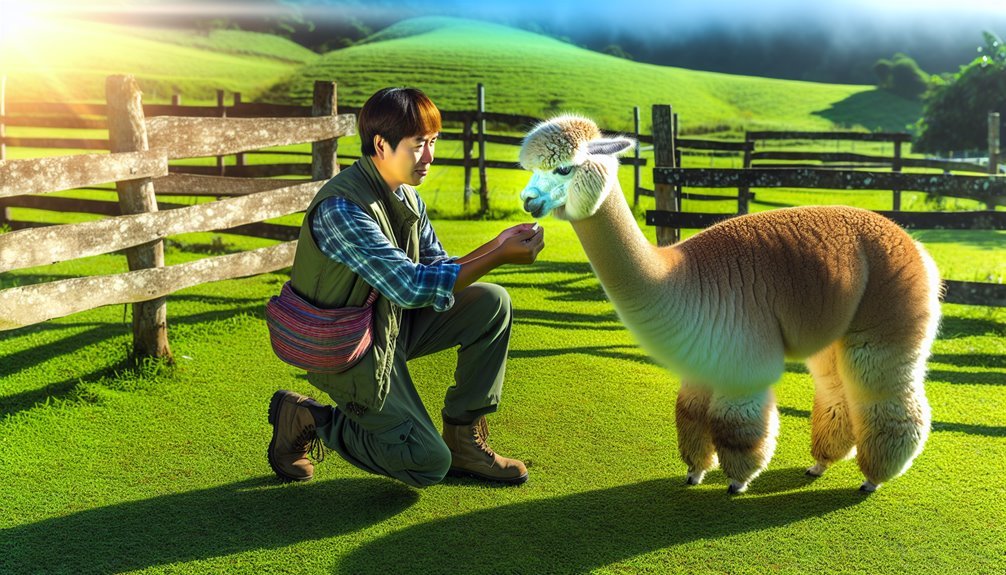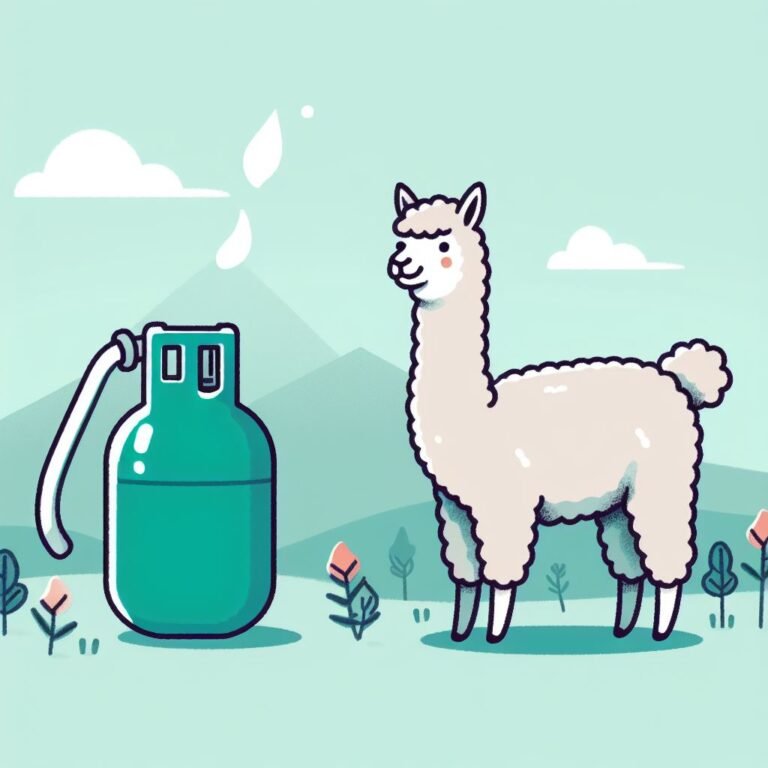Beginner’s Guide to Training Alpacas Successfully
To train alpacas successfully, start by building trust with gentle, patient handling—approach calmly from the side and avoid sudden movements. Choose a well-fitting halter, letting your alpaca get familiar with it before practice. Begin halter training with young crias in small, secure spaces, using short, consistent sessions and positive reinforcement. Gradually encourage walking on a lead and introduce new experiences calmly to boost confidence. Following these steps sets a strong foundation for more advanced training techniques ahead.
Key Takeaways
- Approach alpacas calmly and gently from the side to build trust and reduce their natural shyness.
- Use a well-fitting halter designed for alpacas, ensuring comfort by allowing space for two fingers between the halter and jaw.
- Start halter training with young crias in small, safe spaces, introducing the halter gradually with positive reinforcement.
- Keep training sessions short, consistent, and rewarding to maintain alpaca engagement and encourage good behavior.
- Socialize alpacas early and introduce new experiences gradually to build confidence and reduce stress during training.
Understanding Alpaca Behavior

Although alpacas are naturally shy and cautious, understanding their behavior is key to building trust and training them effectively. You’ll notice alpacas often dislike being touched on the top of their heads, so approach them gently from the side to help them feel comfortable. Since alpacas respond best to calm, patient handling, keep training sessions brief and use positive reinforcement. It’s important to remember each alpaca has a unique temperament; some may become confident while others stay reserved. Regular interaction helps them get used to being handled, which is vital before moving on to halter training. Observing social behaviors among alpacas can also give you insights, as males often show more curiosity, making training easier when they’re relaxed and engaged.
Preparing for Halter Training
Before you start halter training, it’s essential to choose a halter that fits well and feels comfortable for your alpaca. Building trust comes first, so spend time bonding and letting them get used to your presence. This foundation makes the training process smoother and less stressful for both of you.
Choosing Proper Halter
Choosing the right halter is essential for successful alpaca training and comfort. When training an alpaca, you want a halter that fits well and respects their unique anatomy.
- Choose a halter specifically designed for alpacas, ensuring it supports their nasal breathing for comfort.
- Follow sizing guidelines: small for crias (6-12 months), medium for most adults, and large for bigger males or females.
- Account for fleece thickness; you might need different sizes before and after shearing to maintain proper fit.
- Fit the halter snugly—no slipping, but allow room for two fingers between the jaw and halter for comfort.
Before putting it on, let your alpaca see and smell the halter to ease anxiety during training an alpaca with the new equipment.
Building Trust First
When you want to train an alpaca, building trust is the essential first step. You should let your alpaca approach you at its own pace, making building trust much easier through patience and gentle handling. Start with young alpacas, between 5 to 12 months old, because they’re more open to learning and trusting. Avoid placing your hand on the top of their head—it can make trust-building harder. Instead, take a step toward gradual desensitization by gently stroking their neck, helping them get comfortable with touch. Regular, calm interactions combined with positive reinforcement will make the shift to halter training much easier. Remember, taking these thoughtful steps guarantees your alpaca feels safe and willing to cooperate.
Step-by-Step Cria Halter Training
Although halter training can seem challenging at first, starting with your cria at 5-6 months old and working with a small group of 2-3 alpacas can make the process smoother by encouraging social learning and reducing stress. Begin by letting your cria see and smell the halter to create a calm introduction. Once comfortable, fit the halter snugly with two fingers’ space for comfort. Avoid leaving it on during grazing to prevent stress. Short, consistent sessions help build confidence. To get started, follow these steps:
- Introduce the halter gradually and reward calm behavior.
- Fit the halter properly to guarantee comfort.
- Attach the lead rope and practice in a small, safe pen.
- Incorporate obstacle courses, which are particularly useful for mental and physical stimulation.
Techniques for Walking on a Lead
Since walking on a lead is a new skill for your cria, start training in a small pen where they feel safe and secure. Use gentle lead handling techniques, maintaining a calm demeanor and quiet voice to help them relax. Begin by encouraging sideways movement with gentle tugs on the lead, rewarding your cria’s cooperation by easing tension once they comply. Gradually progress to forward movement in a larger space or near their herd to boost security. Keep training session duration short and consistent to help your cria retain what they learn and adapt to different surfaces comfortably. Remember, patience and positive cria movement encouragement are key to successful walking on a lead.
Building Confidence Through Socialisation

To build your alpaca’s confidence, start with early interaction to help them feel safe and comfortable around you. Introducing them to group social dynamics lets them learn from others, making new experiences less intimidating. Using positive reinforcement methods like treats encourages them to stay engaged and trust the process.
Early Interaction Importance
When you interact with alpacas during their formative months, you’re setting the foundation for their confidence and trust. Using early bonding techniques and socialization strategies, you help reduce their natural shyness. Gentle handling and allowing them to approach you at their own pace are key trust building exercises. Here’s how to make the most of early interactions:
- Keep sessions calm and short to maintain their interest without overwhelming them.
- Use consistent positive reinforcement to encourage curiosity and adventurousness.
- Introduce them gradually to new environments and stimuli to build adaptability.
- Handle them gently, letting them set the interaction pace for a positive bond.
These steps foster a confident, well-adjusted alpaca ready for successful training later on.
Group Social Dynamics
Three key benefits come from introducing alpacas to group social dynamics early on: increased confidence, reduced anxiety, and improved adaptability. When you use group bonding strategies like regular walks and cooperative training sessions, your alpacas learn to trust each other and feel safer exploring new environments. You’ll notice shy alpacas picking up behaviors by watching their more confident peers—this is one of the social learning benefits that naturally boosts their skills and comfort levels. Training in pairs or small groups creates a supportive setting where alpacas can grow together, reducing stress during unfamiliar experiences. By encouraging group interaction early, you set the stage for a well-adjusted herd that works cooperatively, making your training efforts smoother and more effective overall.
Positive Reinforcement Methods
Building on the benefits of group social dynamics, using positive reinforcement methods can further boost your alpacas’ confidence and willingness to learn. Treat rewards and clicker training are key tools to encourage engagement and reduce anxiety. Here’s how you can apply these methods effectively:
- Use short, consistent sessions with treat rewards to create positive learning associations.
- Incorporate clicker training to mark desired behaviors clearly and build trust.
- Socialize alpacas with calm peers and humans to promote anxiety reduction and relaxation.
- Gradually expose them to new environments, rewarding calm behavior to enhance adaptability.
Advanced Training Activities
Although alpacas are naturally shy, you can help them become more confident by introducing advanced training activities like obstacle courses and interactive games. Obstacle courses encourage your alpaca to navigate new environments, boosting adaptability and overcoming timidity. You can also teach color recognition using clicker training and rewards, helping your alpaca distinguish between different colored objects during sessions. Another engaging activity is cart pulling, where your alpaca learns to pull small carts or wagons. This not only provides physical exercise but also strengthens your bond. Remember to keep training consistent and use positive reinforcement, so your alpaca enjoys learning these complex tasks. These activities challenge their minds and bodies, making training both fun and rewarding for you and your alpaca.
Creating a Positive Training Environment
When you create a calm and quiet training space free from distractions, your alpaca will feel more secure and focused during sessions. A proper training space setup is essential to enhancing alpaca focus and ensuring productive learning. To build a positive training environment, follow these steps:
- Design a distraction free environment by minimizing noise and movement around the training area.
- Use positive reinforcement like treats or clicker training to encourage good behavior and strengthen trust.
- Introduce new experiences gradually, helping your alpaca adapt confidently without stress.
- Keep sessions short and consistent, always ending on a positive note to maintain engagement.
Approaching your alpaca gently from the side also fosters trust and reduces stress, vital for success.
Frequently Asked Questions
How to Start an Alpaca Farm for Beginners?
You’ll want to start your alpaca farm with proper farm setup, ensuring secure fencing and shelter. Learn alpaca care basics, follow feeding guidelines carefully, and begin with a few alpacas to manage their needs effectively.
What Not to Do Around Alpacas?
Did you know sudden loud noises can increase alpacas’ stress by 70%? You should avoid sudden movements, loud noises, and neglecting grooming to keep them calm and healthy, ensuring a trusting and peaceful environment for your alpacas.
How Do You Train an Alpaca?
You’ll want to use positive reinforcement techniques like treats and praise, apply socialization strategies to build trust, and focus on basic command training by starting with handling, haltering, and walking on a lead in calm sessions.
How Many Alpacas Are on 1 Acre?
You’ll want to cherish your alpaca grazing space wisely; ideally, 6 to 8 alpacas per acre balance herd dynamics well. Thoughtful land management keeps your alpacas happy, healthy, and prevents stress from overcrowding.








Our picks
Alpaca & Wool Felted Sole Inserts: Comfy Upgrade?
Best Alpaca Socks for Hiking: Ultimate Comfort and Durability on Trails
Best Alpaca Halter for Comfort and Control